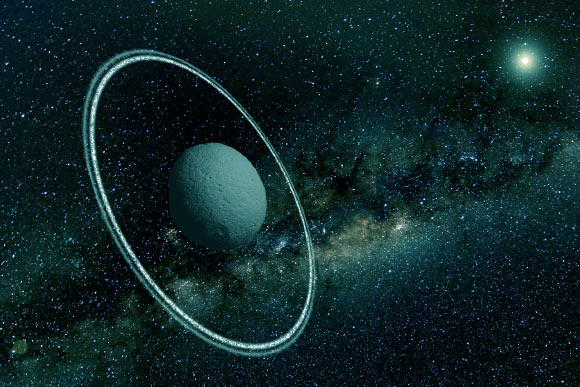Scientists led by Dr Felipe Braga-Ribas from Observatório Nacional/MCTI in Rio de Janeiro, Brazil, have observed for the first time a minor planet with dense and narrow rings.
The object, called Chariklo, is the largest member of a class known as the Centaurs. It is 250-km in diameter and located between Saturn and Uranus about 2 billion km away. It is only the fifth body in the Solar System found to have rings.
The origin of the Chariklo’s rings remains a mystery, but they may be the result of a collision that created a disc of debris.
Dr Braga-Ribas explained: “we weren’t looking for a ring and didn’t think small bodies like Chariklo had them at all, so the discovery – and the amazing amount of detail we saw in the system – came as a complete surprise!”
Predictions had shown that Chariklo would pass in front of the star UCAC4 248-108672 on 3 June 2013, as seen from South America. Dr Braga-Ribas with colleagues used telescopes at seven different locations to watch the star apparently vanish for a few seconds as its light was blocked by Chariklo.
But they found much more than they were expecting. A few seconds before, and again a few seconds after the main occultation there were two further very short dips in the star’s apparent brightness. Something around Chariklo was blocking the light!
By comparing what was seen from different sites the team could reconstruct not only the shape and size of the object itself but also the shape, width, orientation and other properties of the newly discovered rings.
The team found that the ring system consists of two sharply confined rings only 7 and 3 km wide, separated by a clear gap of 9 km.
“We were not even looking for rings, because they had never been observed around small objects like Chariklo, so it is a totally surprising discovery,” said Dr Uffe Grae Jorgensen from the University of Copenhagen’s Niels Bohr Institute, Denmark, who is a co-author of the paper published online in the journal Nature (full paper in .pdf).
“The entire passage only lasted 5 seconds, but we could even determine incredible details about the rings. There are two separate thin rings, which are comprised of ice particles and pebbles. The two rings are only 3 and 7 km wide and no more than a few hundred meters thick. There are 14 km between the centers of the two rings and there is a 9 km wide gap between them. They have been measured at a distance of 2 billion km with an accuracy of plus/minus a few hundred meters. It is really impressive.”
Dr Jorgensen added: “for me, it was quite amazing to realize that we were able not only to detect a ring system, but also pinpoint that it consists of two clearly distinct rings.”
“I try to imagine how it would be to stand on the surface of this icy object and stare up at a 20-km wide ring system 1,000 times closer than the Moon.”
Although many questions remain unanswered, astronomers think that this sort of ring is likely to be formed from debris left over after a collision. It must be confined into the two narrow rings by the presence of small putative satellites.
“So, as well as the rings, it’s likely that Chariklo has at least one small moon still waiting to be discovered,” Dr Braga-Ribas said.
The rings may prove to be a phenomenon that might in turn later lead to the formation of a small moon. Such a sequence of events, on a much larger scale, may explain the birth of our own Moon in the early days of the Solar System, as well as the origin of many other satellites around planets and asteroids.
The astronomers are provisionally calling the rings by the nicknames Oiapoque and Chuí, two rivers near the northern and southern extremes of Brazil.
______
F. Braga-Ribas et al. A ring system detected around the Centaur (10199) Chariklo. Nature, published online March 26, 2014; doi: 10.1038/nature13155








